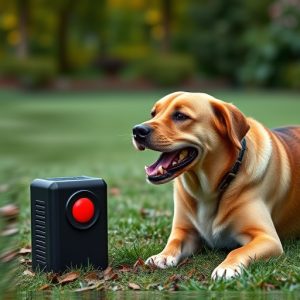Electronic Dog Deterrents: Effective Aggression Management Through Sonic Repellents
Aggressive dog behavior can be modified using electronic deterrents like sonic repellents, which emp…….
Aggressive dog behavior can be modified using electronic deterrents like sonic repellents, which employ specific frequencies to create negative associations and discourage aggression. The success of these devices hinges on adjusting training levels to teach dogs to avoid triggering environments or stimuli without causing discomfort. Starting at lower intensities during initial training ensures positive reinforcement through encouraging natural evasion of aggressive responses to unpleasant noises. Regular practice sessions with adjustable settings promote a humane, effective approach to dog behavior modification.
“Unleash a safer, more controlled environment with an aggressive dog deterrent electronic solution. This comprehensive guide explores the intricate relationship between dog behavior and aggression, shedding light on why electronic deterrents are effective. We delve into the science behind sonic repellents, highlighting the art of adjusting training levels for optimal effectiveness.
From selecting the right device to implementation tips, this article equips pet owners with knowledge to make informed choices, ensuring a harmonious coexistence with their furry companions.”
- Understanding Aggressive Behavior in Dogs and Why Electronic Deterrents Are Effective
- How Sonic Repellents Work: Adjusting Training Levels for Optimal Effectiveness
- Choosing the Right Electronic Dog Deterrent: Key Features and Considerations
- Safe Implementation and Training Tips for a Successful Transition with Your Dog
Understanding Aggressive Behavior in Dogs and Why Electronic Deterrents Are Effective
Aggressive behavior in dogs is a complex issue, often stemming from fear, territorial instincts, or past trauma. When a dog feels threatened or stressed, it may exhibit defensive aggression as a way to protect itself or its territory. Understanding these triggers is crucial when considering electronic deterrents as a solution. These devices, such as sonic repellents, work by emitting sounds at specific frequencies that are unpleasant to dogs, thereby creating a negative association with the area and discouraging aggressive behavior.
Adjusting the training levels of a sonic repellent is key to its effectiveness. By gradually increasing the sensitivity and intensity of the sound, dogs can learn to associate certain environments or stimuli with discomfort, encouraging them to avoid those areas altogether. This process allows for positive reinforcement, as the dog naturally avoids displaying aggressive tendencies in response to the unpleasant noise. As a result, electronic deterrents provide a humane and non-invasive way to modify canine behavior without resorting to punishment methods.
How Sonic Repellents Work: Adjusting Training Levels for Optimal Effectiveness
Sonic repellents are an effective and humane way to deter aggressive dogs without causing them harm. These devices emit high-frequency sound waves that are unpleasant to dogs, encouraging them to stay away from a particular area. The key to their success lies in adjusting sonic repellent training levels.
By modifying the intensity and frequency of the sounds, owners can tailor the device to their dog’s specific sensitivity. Starting at lower settings during initial training allows the dog to learn the association between the sound and the desired behavior without discomfort. Gradually increasing the level as the dog becomes accustomed ensures optimal effectiveness while minimizing any potential stress or annoyance. Regular practice sessions with adjustable sonic repellents foster a positive learning environment, enabling dogs to understand and respond to the non-verbal cues effectively.
Choosing the Right Electronic Dog Deterrent: Key Features and Considerations
When selecting an electronic dog deterrent, it’s crucial to consider features that cater to your specific needs and your pet’s behavior. A reputable solution should offer adjustable training levels, allowing you to customize the intensity of the stimulus according to your dog’s response. This feature is key for effective yet humane training, ensuring the correct balance between deterrence and comfort.
Additionally, look for products with automatic sensitivity adjustment, which can detect and adapt to different environments and dog sizes. Other notable features include a long-range activation, waterproof design for outdoor use, and a user-friendly control panel. Remember, the best deterrent is one that promotes positive behavior change through consistent, safe, and responsive training.
Safe Implementation and Training Tips for a Successful Transition with Your Dog
Implementing an aggressive dog deterrent electronic solution requires careful consideration and a structured approach to ensure a safe and successful transition for both you and your pet. Start by gradually introducing the device, allowing your dog to adjust to the subtle sounds or vibrations it emits. Begin with lower training levels, gradually increasing intensity as your dog becomes more accustomed. This process is key to preventing shock or fear responses.
During training, create a positive association with the device by rewarding calm behavior in its presence. Use treats, praise, or playtime to reinforce that the electronic repellent is not a source of punishment but rather a guide towards better behavior. Consistency and patience are vital; maintain regular training sessions and be prepared for setbacks. Regularly review and adjust the training levels as your dog’s comfort and understanding evolve.
Electronic dog deterrents, especially sonic repelents, offer a safe and effective way to address aggressive behavior. By understanding how these devices work and adjusting training levels accordingly, pet owners can effectively train their dogs without resorting to harmful methods. Remember, proper implementation and consistent training are key to success. When choosing an electronic deterrent, consider features like range, adjustable sensitivity, and human-safe frequency ranges. With the right approach, you can transform a potentially aggressive dog into a well-behaved companion, enhancing both your safety and the quality of your relationship with your pet.


